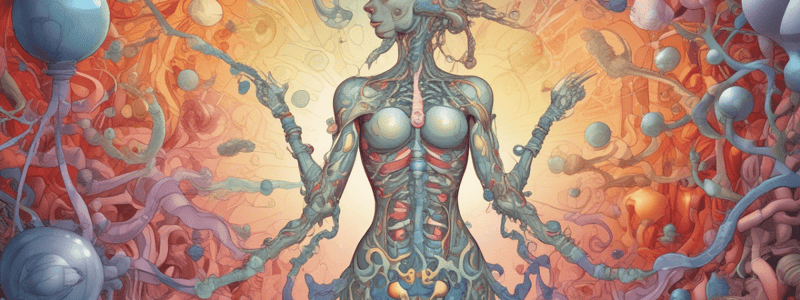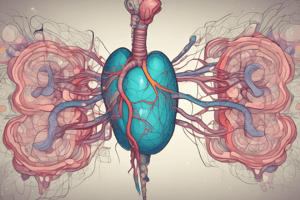Podcast
Questions and Answers
What determines the rate of removal of a hormone from the circulation?
What determines the rate of removal of a hormone from the circulation?
- The amount of hormone in the circulation
- The rate of synthesis of the hormone
- The type of hormone, whether water-soluble or lipid-soluble
- It is fairly constant for a given hormone (correct)
What is the main difference in half-lives between water-soluble and lipid-soluble hormones?
What is the main difference in half-lives between water-soluble and lipid-soluble hormones?
- There is no significant difference in half-lives
- Water-soluble hormones have longer half-lives
- Lipid-soluble hormones have shorter half-lives
- Water-soluble hormones have shorter half-lives (correct)
What type of hormone interaction occurs when one hormone cannot exert its effects without another hormone being present?
What type of hormone interaction occurs when one hormone cannot exert its effects without another hormone being present?
- Synergism
- Permissiveness (correct)
- Antagonism
- Negative feedback
What is the main mechanism by which blood levels of hormones are controlled?
What is the main mechanism by which blood levels of hormones are controlled?
What type of stimulus causes the parathyroid glands to secrete parathyroid hormone (PTH)?
What type of stimulus causes the parathyroid glands to secrete parathyroid hormone (PTH)?
What type of nervous system fibers stimulate the adrenal medulla to secrete catecholamines?
What type of nervous system fibers stimulate the adrenal medulla to secrete catecholamines?
What is the main function of hormones in the body?
What is the main function of hormones in the body?
What type of hormone interaction occurs when more than one hormone produces the same effects on a target cell?
What type of hormone interaction occurs when more than one hormone produces the same effects on a target cell?
Which of the following is NOT directly controlled or influenced by the Endocrine System?
Which of the following is NOT directly controlled or influenced by the Endocrine System?
How does the endocrine system maintain homeostasis in the body?
How does the endocrine system maintain homeostasis in the body?
Which of the following is an example of a negative feedback mechanism within the endocrine system?
Which of the following is an example of a negative feedback mechanism within the endocrine system?
Which of the following is NOT a function of the endocrine system related to reproduction?
Which of the following is NOT a function of the endocrine system related to reproduction?
What is the primary function of homeostasis in the body?
What is the primary function of homeostasis in the body?
What can happen if homeostasis is disrupted?
What can happen if homeostasis is disrupted?
What is the effect of ADH on the distal nephron tubule and collecting duct?
What is the effect of ADH on the distal nephron tubule and collecting duct?
What is the term for the condition resulting from inadequate ADH production and release?
What is the term for the condition resulting from inadequate ADH production and release?
Which of the following hormones is produced by the hypothalamus?
Which of the following hormones is produced by the hypothalamus?
What is the primary function of ADH in the body?
What is the primary function of ADH in the body?
Which of the following is an example of a nonsteroidal hormone?
Which of the following is an example of a nonsteroidal hormone?
What is the term for the condition resulting from hypersecretion of GH in children?
What is the term for the condition resulting from hypersecretion of GH in children?
Which of the following hormones cannot cross cell membranes easily?
Which of the following hormones cannot cross cell membranes easily?
What is the term for the condition resulting from hypersecretion of GH in adults?
What is the term for the condition resulting from hypersecretion of GH in adults?
Which of the following is NOT a characteristic of positive feedback mechanisms?
Which of the following is NOT a characteristic of positive feedback mechanisms?
In the example provided for positive feedback, what is the role of oxytocin?
In the example provided for positive feedback, what is the role of oxytocin?
Which of the following statements accurately describes the role of calcitonin in the regulation of blood calcium levels?
Which of the following statements accurately describes the role of calcitonin in the regulation of blood calcium levels?
Which of the following scenarios is most likely to be regulated by a negative feedback mechanism?
Which of the following scenarios is most likely to be regulated by a negative feedback mechanism?
What is the primary function of the parathyroid hormone in the regulation of blood calcium levels?
What is the primary function of the parathyroid hormone in the regulation of blood calcium levels?
What is the key difference between positive and negative feedback mechanisms?
What is the key difference between positive and negative feedback mechanisms?
Flashcards are hidden until you start studying
Study Notes
Hormone Removal and Interaction
- The rate of removal from the circulation is fairly constant for a given hormone.
- The length of time it takes to remove half of the amount of hormone from the circulation is the half-life of that hormone.
- Water-soluble hormones have shorter half-lives than lipid-soluble hormones due to rapid degradation in the kidney, liver, and lungs.
- Hormones with short half-lives exhibit rapid changes in hormone levels.
Types of Hormone Interaction
- Permissiveness: one hormone cannot exert its effects without another hormone being present.
- Synergism: more than one hormone produces the same effects on a target cell.
- Antagonism: one or more hormones opposes the action of another hormone.
Blood Levels of Hormones
- Blood levels of hormones are controlled by negative feedback systems.
- Hormone levels vary only within a narrow desirable range.
- Hormones are synthesized and released in response to humoral stimuli, neural stimuli, and hormonal stimuli.
Humoral Stimuli
- Humoral stimuli are the simplest of endocrine control mechanisms.
- Hormone secretion occurs in direct response to changing blood levels of ions and nutrients.
- Example: declining blood Ca2+ concentration stimulates the parathyroid glands to secrete PTH, which causes Ca2+ concentrations to rise and the stimulus is removed.
Neural Stimuli
- Neural stimuli involve nerve fibers that stimulate hormone release.
- Example: the preganglionic sympathetic nervous system (SNS) fibers stimulate the adrenal medulla to secrete catecholamines.
Hormonal Stimuli
- Hormonal stimuli involve the release of hormones in response to hormones produced by other endocrine organs.
- Example: the hypothalamic hormones stimulate the anterior pituitary, which in turn stimulates target cells to secrete hormones.
Functions of the Endocrine System
- Maintenance of the internal environment in the body (maintaining the optimum biochemical environment).
- Integration and regulation of growth and development.
- Control, maintenance, and instigation of sexual reproduction, including gametogenesis, coitus, fertilization, fetal growth and development, and nourishment of the newborn.
Homeostasis
- Homeostasis is the ability of the human body to maintain relatively stable internal conditions despite changes in the outside world.
- A good homeostasis is indispensable to maintain the organism in good health.
- Most diseases can be regarded as a result of disturbance of homeostasis.
Feedback Systems
- Negative feedback mechanisms cause the variable to change in a direction opposite to that of the initial change.
- Positive feedback mechanisms cause the variable to accelerate the change in the same direction as the initial disturbance.
Endocrine System in Feedback Mechanisms
- Negative feedback mechanisms: Parathyroid hormone is released in response to declining blood Ca2+ concentration, which stimulates osteoclasts to resorb bone, releasing calcium to the blood, and calcitonin hormone is released to inhibit osteoclasts and encourage calcium salt deposit in bone matrix.
- Positive feedback mechanisms: Oxytocin stimulates milk letdown and contraction of the uterus, and prolactin stimulates milk production.
Pituitary Gland: Parts and Hormones
- Posterior lobe: stores hormones oxytocin and antidiuretic hormone (ADH).
- Anterior lobe: makes and releases hormones such as thyroid-stimulating hormone (TSH), adrenocorticotropic hormone (ACTH), luteinizing hormone (LH), follicle-stimulating hormone (FSH), melanocyte-stimulating hormone (MSH), and prolactin (PRL).
- Hormones produced by the hypothalamus and released by the posterior pituitary: oxytocin and antidiuretic hormone (ADH).
Hormonal Control of Water Retention in the Body
- The body controls water retention through the hormone antidiuretic hormone (ADH), released by the posterior pituitary gland.
- ADH increases permeability to water in the distal nephron tubule and collecting duct, leading to more water moving out of the nephron tubule and collecting duct and back into circulation.
Disorders
- Gigantism: hypersecretion of GH in children.
- Acromegaly: hypersecretion of GH in adults.
- Pituitary dwarfism: hyposecretion of GH.
- Diabetes insipidus: inadequate ADH produced and released.
Studying That Suits You
Use AI to generate personalized quizzes and flashcards to suit your learning preferences.




